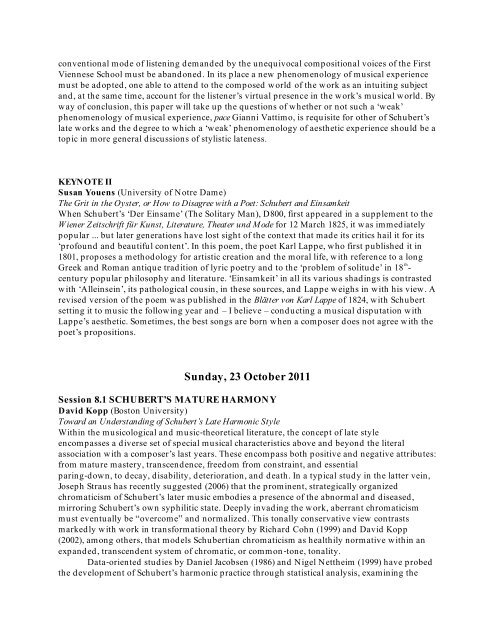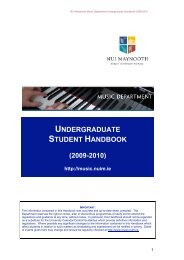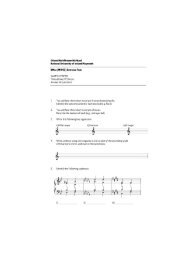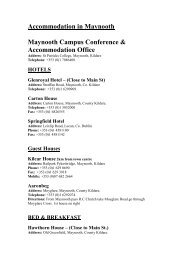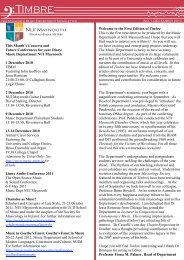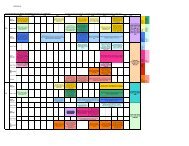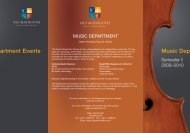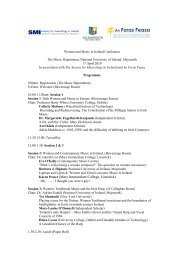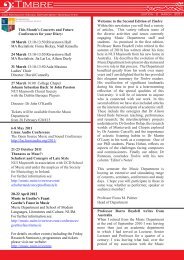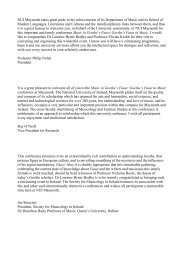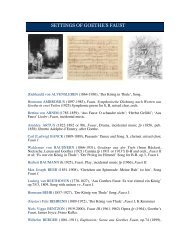Conference Booklet - Music - National University of Ireland, Maynooth
Conference Booklet - Music - National University of Ireland, Maynooth
Conference Booklet - Music - National University of Ireland, Maynooth
Create successful ePaper yourself
Turn your PDF publications into a flip-book with our unique Google optimized e-Paper software.
conventional mode <strong>of</strong> listening demanded by the unequivocal compositional voices <strong>of</strong> the First<br />
Viennese School must be abandoned. In its place a new phenomenology <strong>of</strong> musical experience<br />
must be adopted, one able to attend to the composed world <strong>of</strong> the work as an intuiting subject<br />
and, at the same time, account for the listener‘s virtual presence in the work‘s musical world. By<br />
way <strong>of</strong> conclusion, this paper will take up the questions <strong>of</strong> whether or not such a ‗weak‘<br />
phenomenology <strong>of</strong> musical experience, pace Gianni Vattimo, is requisite for other <strong>of</strong> Schubert‘s<br />
late works and the degree to which a ‗weak‘ phenomenology <strong>of</strong> aesthetic experience should be a<br />
topic in more general discussions <strong>of</strong> stylistic lateness.<br />
KEYNOTE II<br />
Susan Youens (<strong>University</strong> <strong>of</strong> Notre Dame)<br />
The Grit in the Oyster, or How to Disagree with a Poet: Schubert and Einsamkeit<br />
When Schubert‘s ‗Der Einsame‘ (The Solitary Man), D800, first appeared in a supplement to the<br />
Wiener Zeitschrift für Kunst, Literature, Theater und Mode for 12 March 1825, it was immediately<br />
popular ... but later generations have lost sight <strong>of</strong> the context that made its critics hail it for its<br />
‗pr<strong>of</strong>ound and beautiful content‘. In this poem, the poet Karl Lappe, who first published it in<br />
1801, proposes a methodology for artistic creation and the moral life, with reference to a long<br />
Greek and Roman antique tradition <strong>of</strong> lyric poetry and to the ‗problem <strong>of</strong> solitude‘ in 18 th -<br />
century popular philosophy and literature. ‗Einsamkeit‘ in all its various shadings is contrasted<br />
with ‗Alleinsein‘, its pathological cousin, in these sources, and Lappe weighs in with his view. A<br />
revised version <strong>of</strong> the poem was published in the Blätter von Karl Lappe <strong>of</strong> 1824, with Schubert<br />
setting it to music the following year and – I believe – conducting a musical disputation with<br />
Lappe‘s aesthetic. Sometimes, the best songs are born when a composer does not agree with the<br />
poet‘s propositions.<br />
Sunday, 23 October 2011<br />
Session 8.1 SCHUBERT’S MATURE HARMONY<br />
David Kopp (Boston <strong>University</strong>)<br />
Toward an Understanding <strong>of</strong> Schubert’s Late Harmonic Style<br />
Within the musicological and music‐theoretical literature, the concept <strong>of</strong> late style<br />
encompasses a diverse set <strong>of</strong> special musical characteristics above and beyond the literal<br />
association with a composer‘s last years. These encompass both positive and negative attributes:<br />
from mature mastery, transcendence, freedom from constraint, and essential<br />
paring‐down, to decay, disability, deterioration, and death. In a typical study in the latter vein,<br />
Joseph Straus has recently suggested (2006) that the prominent, strategically organized<br />
chromaticism <strong>of</strong> Schubert‘s later music embodies a presence <strong>of</strong> the abnormal and diseased,<br />
mirroring Schubert‘s own syphilitic state. Deeply invading the work, aberrant chromaticism<br />
must eventually be ―overcome‖ and normalized. This tonally conservative view contrasts<br />
markedly with work in transformational theory by Richard Cohn (1999) and David Kopp<br />
(2002), among others, that models Schubertian chromaticism as healthily normative within an<br />
expanded, transcendent system <strong>of</strong> chromatic, or common ‐tone, tonality.<br />
Data‐oriented studies by Daniel Jacobsen (1986) and Nigel Nettheim (1999) have probed<br />
the development <strong>of</strong> Schubert‘s harmonic practice through statistical analysis, examining the


